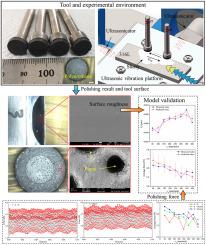Two-dimensional ultrasonic vibration-assisted grind-polishing of MFC valve surface with an innovative SPPU tool
IF 4.3
2区 材料科学
Q2 ENGINEERING, CHEMICAL
引用次数: 0
Abstract
Ultra-precision machining technology received relatively little attention in the machining of key components for semiconductor equipment, such as the seal surfaces of mass flow controller (MFC). The machining quality of these features is vital to the corrosion resistance of MFC valve body. Currently, the processing of these features still relies on conventional manual polishing, which will lead to uncertainty in surface quality. Therefore, this article employs a special fabricated sinter pouring polyurethane (SPPU) grind-polishing tool to conduct two-dimensional ultrasonic vibration-assisted polishing experiments, with a focus on the tool's performance. The machining mechanism of the tool was analyzed. Taking into account the ultrasonic cavitation effect, the penetration depth of a single grain was calculated, and established a surface roughness model. Through experiments, it was found that as the amplitude increased, the surface roughness showed a decreasing trend, reaching as low as 0.003 μm, but the change in polishing force exhibited an opposite trend. Additionally, the material removal efficiency significantly improves with the increase of amplitude. The processed surface had a reduced carbon content and no oxygen element, indicating the stable machining performance of the tool. This article provides effective reference for the automated processing of MFC valve body features.

基于SPPU工具的MFC阀表面二维超声振动辅助磨削抛光
在质量流量控制器(MFC)密封表面等半导体设备关键部件的加工中,超精密加工技术受到的关注相对较少。这些特性的加工质量对MFC阀体的耐腐蚀性能至关重要。目前,这些特征的加工仍然依赖于传统的手工抛光,这将导致表面质量的不确定性。因此,本文采用特制的烧结浇注聚氨酯(SPPU)研磨抛光工具进行二维超声振动辅助抛光实验,重点研究该工具的性能。分析了刀具的加工机理。考虑超声空化效应,计算了单颗粒的侵彻深度,建立了表面粗糙度模型。通过实验发现,随着振幅的增大,表面粗糙度呈下降趋势,低至0.003 μm,但抛光力的变化趋势相反。此外,随着振幅的增加,材料去除效率显著提高。加工表面碳含量降低,无氧元素,表明刀具加工性能稳定。本文为MFC阀体特性的自动化加工提供了有效的参考。
本文章由计算机程序翻译,如有差异,请以英文原文为准。
求助全文
约1分钟内获得全文
求助全文
来源期刊

Particuology
工程技术-材料科学:综合
CiteScore
6.70
自引率
2.90%
发文量
1730
审稿时长
32 days
期刊介绍:
The word ‘particuology’ was coined to parallel the discipline for the science and technology of particles.
Particuology is an interdisciplinary journal that publishes frontier research articles and critical reviews on the discovery, formulation and engineering of particulate materials, processes and systems. It especially welcomes contributions utilising advanced theoretical, modelling and measurement methods to enable the discovery and creation of new particulate materials, and the manufacturing of functional particulate-based products, such as sensors.
Papers are handled by Thematic Editors who oversee contributions from specific subject fields. These fields are classified into: Particle Synthesis and Modification; Particle Characterization and Measurement; Granular Systems and Bulk Solids Technology; Fluidization and Particle-Fluid Systems; Aerosols; and Applications of Particle Technology.
Key topics concerning the creation and processing of particulates include:
-Modelling and simulation of particle formation, collective behaviour of particles and systems for particle production over a broad spectrum of length scales
-Mining of experimental data for particle synthesis and surface properties to facilitate the creation of new materials and processes
-Particle design and preparation including controlled response and sensing functionalities in formation, delivery systems and biological systems, etc.
-Experimental and computational methods for visualization and analysis of particulate system.
These topics are broadly relevant to the production of materials, pharmaceuticals and food, and to the conversion of energy resources to fuels and protection of the environment.
 求助内容:
求助内容: 应助结果提醒方式:
应助结果提醒方式:


